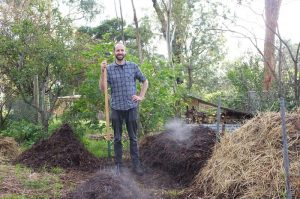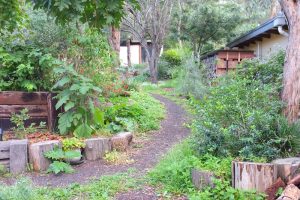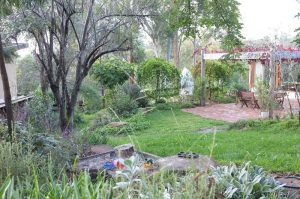Dan Milne – home gardening as part of local and resilient food networks
Ann Stanley talks to Dan Milne, from Montmorency, about food gardening. The interview took place during the COVID-19 crisis.
 Dan Milne is a Design Lecturer, active member of NERP (North East Region Permaculture), husband, father and passionate home gardener.
Dan Milne is a Design Lecturer, active member of NERP (North East Region Permaculture), husband, father and passionate home gardener.
Dan lives with his wife, Liz, and two young daughters in a mudbrick house in Montmorency that was built in 1948 by Tim and Betty Burstall. The house is on 1400m2 of partially shaded sloping land that produces a large number of fruits and vegetables according to permaculture principles (the list at the end of this article shows the wonderful diversity of the perennial plantings being grown). Dan completed his Permaculture Design Certificate with Pete the Permie in 2017. The garden is around four years old and the photos show how much can be achieved in a short time by a family with work outside the home as well as two young children  to care for.
to care for.
It took Dan and I a few weeks to set up our interview because of the great disruption that COVID-19 has caused. After a few false starts we got there, though it must be said that it was weird to interview a person about their garden by Zoom. Inevitably, we discussed the issues of food security, resilience and the role of local food communities in times of crisis, as well as gardening in general. The material below provides Dan’s answers to each of my questions.
What kind of yield can a home garden achieve?
We have had a steady yield from our garden this season with some produce from most of the fruit trees.  We try to eat continually from the garden. I have found that the best yields in the vegetable garden come during the milder Spring and Autumn conditions. In recent years, the timing and intensity of Winter and Summer have become unpredictable so you need to be looking carefully for early signs of moderation.
We try to eat continually from the garden. I have found that the best yields in the vegetable garden come during the milder Spring and Autumn conditions. In recent years, the timing and intensity of Winter and Summer have become unpredictable so you need to be looking carefully for early signs of moderation.
With all the rain we’ve had in recent months, we have been picking a lot of mushrooms which are everywhere on the property because we’ve been using a lot of mushroom compost. There are also lots to be foraged in surrounding reserves. Permaculture recommends valuing the marginal and using the edges of the site available to you. We also make use of the open space in the orchard to grow broad beans over winter when the  fruit trees are dormant.
fruit trees are dormant.
How does a garden help in a time of isolation?
In my specific case, it is a large beautiful play space for our children. More generally, gardens are a focus for people. Lots of people are buying pets at the moment and a garden can fulfil the same urge. You can focus on plants just as you focus on pets.
What is the role of backyard gardening in food security?
Growing food in good times can feel like a hobby with mental health benefits but, in times of disruption and crisis, it can provide a source of nutrient-dense food and a sense that you have some control over your basic needs — an opportunity to catch and store energy.
The hoarding that’s been going on lately in response to the COVID-19 virus highlights how little resilience people have to food shortages or, in this case, perceived shortages. I think that the impulse to hoard food and keep it for yourself and your own family comes from the same impulse as preserving food, but the difference is that preserving usually comes in response to a glut and the product is often shared in a community. There’s no doubt that it’s a good idea to have more in our pantries and less reliance on the supermarket storing our food for us. And, of course, preserving in a time of glut reduces the embodied energy in the food that we’re consuming.
How should we see the relationship of food production and consumption?
At the moment in the dominant food system, we have a complete separation of consumers and producers. In the current crisis, there’s a great opportunity for developing relationships around food, building strong local connections and having more involvement with our own food supply. This involvement allows us to express direct gratitude to people who grow our food. Knowing the people who grow your food is reassuring. It fosters a sense of mutual reliance and support for each-other, reducing waste in times of glut and ensuring a fair share in times of scarcity.
What opportunities might the current crisis afford?
Food supply is not an obvious problem in our society right now but it is likely to become less reliable with situations like pandemic and crises caused by economic downturns, declining oil reserves and climate change. There is already concern around the affordability of healthy organic food. In the future, more city gardens could produce fresh, nutrient-dense food while larger, broad-scale enterprises could produce staples like wheat.
Home food growing is the flavour of the month and permaculture feels more relevant than ever. In direct response to the current situation, companies like Eden Seeds and Bulleen Art and Garden have been inundated with people inspired to grow their own food. It is possible that people will put a lot of effort into gardening during their time of isolation as a one-off thing and then revert back to their reliance on the supermarket. I think that the best approach for people relatively new to food growing is to start small and build confidence in growing some of the easier, more reliable crops using the compost and other resources that they generate themselves. They can then use this (positive) experience as a spark to more sustained and extensive growing in the future.
Here is a list of the perennial or naturalised food crops growing in Dan’s garden. Fruit: alpine strawberry, apple, avocado, blackberry, blackcurrant, blueberry, boysenberry, cherry, cherry guava, cranberry, feijoa, fig, hawthorn, kei apple, lemon, lime, mulberry, nashi, navel orange, nectarine, olive, peach, persimmon, plum, pomegranate, raspberry, redcurrant, strawberry, tayberry and youngberry. Veggies and herbs (some of which are edible weeds): asparagus, blackberry nightshade, chives, comfrey, curry leaf, devils fig (grafted eggplant), flickweed (wild cress), gota kola, horseradish, jerusalem artichoke, lebanese cress, mallow, manzano rocoto chilli, nasturtium, perennial leeks, rhubarb, salsify, upland cress, walking onions, warrigal greens and wild broccoli.

I’d love to hear more about the devils fig. Is it grafted to a normal eggplant or do you eat the devils fig fruit? I have been looking for a rootstock for grafting eggplants for a while.
Hi Penny. I’m very belatedly replying to your query about the devil’s fig.
The devil’s fig is a vigorous non-edible member of the Solanaceae (nightshade) family which can be used as a root stock for grafting the edible members of the family (eggplant, capsicum, tomatoes, chillies). Its leaves and stems are covered in large spikes (hence the name) and mine grew more than 2 metres in the first year.
Angelo Eliades has an excellent article on his Deep Green Permaculture site:
https://deepgreenpermaculture.com/diy-instructions/grafting-eggplant-onto-devil-plant/
I followed his instructions last year and grafted a tomato and a couple of eggplants to mine. Abundant cherry tomatoes which kept on ripening until July and a few very large eggplants. See
https://user.fm/files/v2-6fc3e1b6e55feb0270d32f0f19bf985e/grafted_eggplant_800px.jpg
It looks as if the grafted parts of the plant did not make it through the winter so I’ll have to re-graft again this season.
I understand that you can also use the native kangaroo apple (Solanum aviculare) for grafting. Also vigorous and without the devilish spikes — something to experiment with!